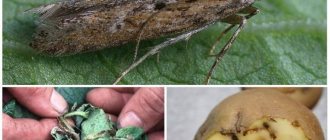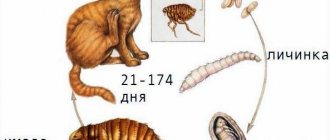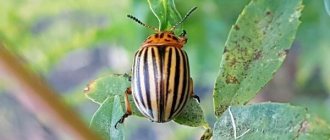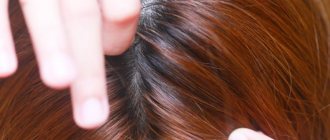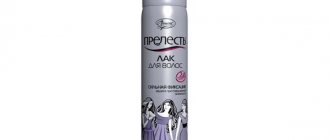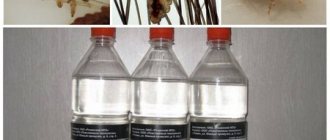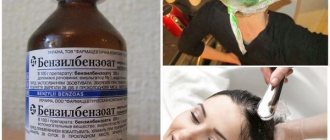Types of lice
Before considering the question of what head lice look like, it is necessary to understand their classification.
In total, there are 3 types of these parasites: head, underwear (clothes) and pubic. Linen lice reproduce and lay eggs exclusively on human clothing or bedding. They move onto the “host’s” body only to feed. Their paws are not designed to live on hair, which cannot be said about their heads. Removing them is quite simple - you need to wash bedding and clothes with a special detergent. The habitats of pubic lice are clear from their name. They are rarely found on men's facial hair and eyelashes.
Symptoms of lice infection
Signs of lice infection include the following:
- detection of lice and nits;
- severe itching on the scalp;
- the appearance of scratches and other damage in places where parasites may be localized;
- presence of bite marks;
- pyoderma (purulent inflammation of the skin);
- formation of hair mats.
Gallery: visual signs of lice
Lice can be detected by visual inspection of the head
You can find not the parasites themselves, but lice nits on the hair
Fresh scratches caused by constant itching also indicate lice.
If pediculosis is not treated, the condition of the scratches worsens.
Lice bites differ from healthy areas of the skin by a small pink or red swelling with a visible puncture site in the middle of the skin. In the most advanced cases of head lice, the hair clumps together, forming a felt-like tangle.
Once on a person, lice begin sucking blood almost immediately or within 2–3 hours, after which the first itching sensations appear.
Myth: Lice do not infest colored hair. This is an incorrect statement. Lice do not feed on hair, they are only interested in the host’s blood, so they don’t care what the hair tastes or color. However, dyeing hair during an infestation with dye containing ammonia can kill a number of individuals.
What do head lice look like?
These small parasites can live and reproduce exclusively on the human body. They predominantly have a gray body color, but in adults it can vary depending on the hair color of the “owner”.
The body of females is slightly elongated and measures about 4 mm. Males are much smaller in size. These insects have 6 legs with hooks located at the ends. Thanks to the latter, they are well attached to the hair and crawl along it unhindered. Insects amaze with their activity. For example, in a minute they can crawl a distance of 25 cm. Head lice are characterized by high fertility. Therefore, in the absence of timely treatment, their number rapidly increases several times.
Adults attach their eggs, called nits, to the hair roots. After about 8-10 days, nymphs emerge from them. This is a transitional stage between eggs and adults. After another 10 days, the nymphs grow completely. From this moment on, they can lay eggs on their own.
Parasites feed on human blood. They obtain it by biting the scalp. These places immediately begin to itch and itch.
Incubation period for lice: how quickly they begin to pester after infection
After infection, the first lice bites occur within the first hours from the moment the parasites enter the human hairline - these insects cannot go without food for more than a few days. However, the bites of one or two individuals that have managed to crawl onto a healthy person are not particularly noticeable and often do not attract attention. Therefore, at this time it is too early to talk about any manifestations of pediculosis.
The real symptoms of head lice begin to be felt after three to four weeks. During this time, the first generation nymphs manage to hatch and grow, and they begin to bite the human scalp en masse.
Under favorable conditions, after three weeks the second generation of lice appears on the head, and due to the large number they already cause serious itching and well-defined discomfort.
On a note
Pediculosis is a set of symptoms common to people with a severe lice infestation. In medical practice, pediculosis is considered a disease and manifests itself in the form of various symptoms caused by the activity of lice: itching, pustules, the appearance of spots and allergic rashes.
Thus, in the case under consideration, such an incubation period for lice can be considered equal to three weeks. It is during this period that all the signs of pediculosis appear on the head: nits, irritation, itching, as well as the possibility of infecting other people.
This is interesting
Depending on a person’s living conditions, the incubation period for the development of pediculosis may vary. For example, in winter conditions or northern latitudes, when a person’s head is constantly covered with a hat, and the room is quite heated, lice develop faster - sometimes in 16 days the full cycle of their reproduction goes through. In mid-latitudes, when a person's head is often exposed, parasites usually take longer to develop.
It is also useful to read: Body lice: features of their appearance and lifestyle
And also: Secrets of getting rid of lice and nits on your own (the article has more)
Life cycle
The head louse spends its entire life on the scalp. If the parasites leave the “host” body for some reason, they die within 1-2 days. They cannot exist on animals.
The development cycle is 30-40 days. During this time, the louse manages to lay about 200-300 nits. Externally, the eggs are similar in size and color to sesame seeds. The female attaches the larva approximately 5 mm from the surface of the skin. During the time it takes for young individuals to hatch from eggs, the hair has time to grow a little. Therefore, nits located more than a centimeter from the skin are usually empty. With each new offspring, lice reproduction becomes more spontaneous.
The life cycle of head lice varies depending on temperature, hair length and the presence of skin diseases. For example, on short hair the parasite cannot deposit a large number of nits. Therefore, reproduction takes longer. The presence of dermatological diseases on the scalp, accompanied by the formation of a crust, also stops this process. At temperatures below +10 degrees, insects can survive without food for no more than 10 days. For example, at a temperature of 32 degrees they die without food on the fourth day. Thus, how long head lice live without humans depends largely on environmental conditions.
Types of lice and reproduction characteristics
There are three types of lice:
- capitates - from 2 to 4 mm in length, live on the hair covering the scalp;
- clothes - up to 5 mm in length, live in bed linen, clothing, and also on the body;
- pubic - up to 1 mm in length, live on the hairs covering the scrotum, pubic area, rarely live in the mustache, beard, eyelashes.
Infection with the first two types occurs through household contact, and with the third through sexual contact.
The main types of lice that parasitize humans.
The head parasite feeds several times a day and lives for about a month. A female louse lays eggs every 6 hours. During her entire short life, the female manages to lay from 120 to 140 eggs.
The lifespan of body lice depends on the sex of the parasite: for males it is a month, for females it is from 1.5 to 2 months. A female of this type makes up to 300 clutches.
Pubic lice live for a month and have a slow reproduction rate compared to other types of parasites - from 26 to 60 eggs during the entire life period.
Favorable conditions
Parasites feel good at room temperature from 25ºС to 28ºС. If the temperature drops to 20ºC, the development of the parasite slows down and the life cycle is shortened. A decrease to a temperature of 12ºC stops the reproduction processes of insects.
A temperature of 40ºC is destructive for lice. Under such conditions, their development slows down and the parasites die.
Distribution routes
Head lice are predominantly found in children and adults with long hair. They are transmitted through personal hygiene products, such as combs or hair ties.
Parasites can appear even in clean people who live in good conditions. They are caused by close contact with an infected person. Parasites pass from the “host” during games, sexual intercourse, wrestling, and accidental touching of the head.
Where do head lice in children come from? In children's groups, the spread of these insects occurs at lightning speed. They can be transmitted to healthy babies through shared towels or pillows, when bathing in the bathtub or wearing other people's hats. Therefore, a high risk of infection is observed in gardens and schools, swimming pools, hotels, and trains.
How dangerous are parasites?
Insects do not carry dangerous diseases that are transmitted through blood. We are talking about AIDS, hepatitis and others.
However, diseases spread by human head lice include typhus. In the stomach of parasites, favorable conditions are created for the growth and further reproduction of individual microorganisms. These include the causative agents of typhus and relapsing fever. They are not transmitted to humans by a bite, as many people think. Infection occurs through excrement or when an insect is crushed. If there are small wounds and other injuries on the skin, the likelihood of developing typhus increases several times. Also, infection cannot be ruled out if the pathogen gets on the mucous membranes.
Pediculosis disease and its symptoms
Pediculosis is a disease caused by head lice. Its prevalence is quite high. Therefore, every person needs to know what symptoms to pay attention to first and what head lice look like.
The first sign of infection is severe itching. Its appearance is caused by an enzyme secreted by the parasite. Most people are allergic to it. At the initial stage, many people perceive itching as a reaction to shampoo or the development of a skin disease (for example, seborrhea). To determine the source of discomfort, you should pay attention to its location. If your head itches behind your ears, you can safely talk about lice. Head lice are clearly visible upon examination.
Another symptom is the presence of nits. Insect eggs are attached directly to the hair. They are white, which only simplifies the search. Sometimes they are confused with dandruff. However, nits are located on the head in the area closer to the neck. In addition, if you try to crush the parasite egg with your fingernails, a characteristic sound will be heard.
In advanced cases, the hair sticks together and tangles form. Due to constant scratching, the course of the disease may be complicated by furunculosis or other pustular lesions. In the absence of treatment, lymphadenitis develops, the lymph nodes in the neck and ears become enlarged and inflamed.
What are nits?
Nits are the eggs laid by the female louse . They attach to human hair a few millimeters from the root using a sticky liquid produced by the insect's gonads.
The protective shell is so reliable that the eggs cannot be washed off with water, even with the addition of shampoo . Nits have an elongated oval shape and look like translucent or yellowish-white seeds.
They are often confused with dandruff until they begin to comb them out, because, unlike dandruff, it is very difficult to remove nits from hair.
Having found out how quickly they reproduce and what the life cycle of head lice is, we understand that we need to start fighting them as quickly as possible.
Pharmacy treatments
The principle of treatment for pediculosis is based on the elimination of lice and the prevention of their further reproduction. For these purposes, special preparations are used in the following forms:
- shampoos;
- aerosols;
- lotions;
- sprays.
Shampoos are considered less effective than those listed above. Their action is aimed at deep penetration into the body of the parasite, as a result of which the insects die. The most popular are “Pedilin” and “Parasidosis”. The product must be applied to damp hair and left for 10-15 minutes. After this, the shampoo should be washed off and the hair should be combed with a comb. This procedure should be repeated once a week. Anti-head lice shampoo should only be used as directed by a doctor. Pregnant and lactating women, as well as children under 3 years of age, should avoid using it.
How to get rid of head lice not only on your head, but also on your clothes? A variety of aerosols are suitable for these purposes (for example, “Para-Plus” and “A-Par”). Some of them are used exclusively for treating clothing, while others can be used to eliminate lice on hair.
Aerosol "A-steam" is designed to eliminate insects from clothing. The product does not leave stains on the material, and the treated items do not require subsequent washing. However, you cannot put them on right away. It is better to leave it to ventilate for several days. It is recommended to process clothes with the window open. If the product gets on the mucous membranes of the eyes, they should be rinsed immediately under running water. It is prohibited to use hair spray as it contains toxic substances. Also, it should not be sprayed near children, other people, asthma patients, or pregnant women.
Para-Plus is considered a safer remedy. The aerosol can be sprayed onto the hair and scalp. After the procedure, you need to shower using regular shampoo. Dead lice and nits should be combed out with a comb. To prevent re-infection, personal hygiene products, underwear and clothing can be treated with this product. The instructions do not recommend it for use by children under 2 years of age and persons prone to allergies.
Various sprays (Paranit, Nyuda, Pediculen Ultra) are good against parasites. The listed drugs have proven themselves to be positive and are highly effective. They are a yellowish oily liquid. It has no characteristic odor. The action of such drugs is aimed at immobilizing insects and rapid death.
“Paranit” instructions recommend applying it to dry hair. After they become a little damp, the product should continue to be rubbed into the roots of the hair. In the case of long curls, they must be combed in separate strands. The applied drug is left for 15 minutes, after which it is washed off with regular shampoo. Dead lice and nits should be combed out with a comb. After this, the head is washed again with Paranit shampoo. If necessary, the procedure should be repeated every 10 days. This product is not recommended for use by pregnant and lactating women, children under 3 years of age and people with dermatological diseases.
Spray "Nuda" has a similar effect. It should also be applied to dry hair and rubbed into the roots. However, you must leave the product on for at least 45 minutes. After time, the remaining spray is washed off with shampoo, and dead parasites are combed out with a comb. The latter is sold together with the drug "Nyuda".
When should you see a doctor?
Over the past decades, lice have developed resistance to the chemicals used to remove them. In rare cases, lice can transmit typhus or fever, but advanced cases can cause pyoderma and purulent skin lesions. To prevent this, at the first sign of lice detection, you need to contact your local physician.
Do you see a doctor if you are diagnosed with lice?
Not really
Complications of pediculosis:
- conjunctivitis;
- inflammation of the edges of the eyelids;
- inflammation of the lymph nodes;
- streptococcal infections;
- bacterial infection (pyoderma) of the face, behind-the-ear areas and scalp;
- typhus (rare).
The doctor will determine the type of lice parasitizing on humans and select the optimal treatment . In addition, the incubation period of head lice is a month. And being in a group with a large number of people can provoke an outbreak of head lice, since the symptoms are not immediately noticeable.
The louse, as an insect, is very interesting for scientists to study. But for people it poses a danger of contracting lice. To avoid illness, you need to regularly carry out hygiene procedures, not use other people’s hygiene items and regularly wash your bed linen. In this case, the risk of infection is reduced to zero. And you don’t have to study the insect on your comb; it’s better to leave this to the specialists.
- about the author
- VK profile
Help from traditional medicine
Sometimes it is not possible to eliminate pediculosis with pharmaceutical products. We are talking about infection during pregnancy or lactation if lice were found in a child under 3 years of age. In this case, it is recommended to use traditional medicine methods. Sometimes more than one treatment procedure may be required, but these methods are completely safe for humans.
The most popular recipes are listed below:
- Tar soap. Apply the product to clean hair, distributing it evenly over the entire length. Particular attention should be paid to the area behind the ears. You need to put a bag on your head and cover it with a towel on top. After an hour, the hair should be thoroughly rinsed under running water and dried. Comb your hair with a comb to remove parasites and their eggs. The procedure can be repeated until complete recovery. In addition, it is recommended to wash the bed linen and clothes of the infected person with tar soap.
- Hellebore water. It is believed that this is the most effective remedy for nits and lice. It is made from the poisonous Lobel hellebore plant, which grows in Eurasia. Using a cotton swab, apply the product to all hair. They must be clean and dry. You then need to put a cap or bag on your head for 30 minutes. After this, rinse your hair well and comb it with a fine-toothed comb.
- Kerosene. This remedy has been used for a long time in the fight against parasites. It is believed that head lice cannot tolerate kerosene. It should be used carefully to avoid burns to the skin. To prepare, you will need to mix a tablespoon of kerosene and shampoo, apply to your head and leave for an hour. Then wash your hair with shampoo, dry it and comb it with a comb. The procedure can be repeated once a week.
- Vinegar. This is another popular remedy used at home to eliminate lice. As with kerosene, it is important to take precautions to prevent burns. You will need 9% table vinegar diluted with water in a 2:1 ratio. Soak a towel in the solution and gently soak your hair in it, avoiding contact with the skin. Place the bag on your head for an hour. Then wash your hair with shampoo, dry and comb with a comb.
It is customary for young children to have their heads cut. Of course, shaving is a rather radical method. However, it allows head lice to be deprived of an environment for feeding and reproduction.
Mechanical removal of lice
In addition to pharmaceutical and folk remedies for the treatment of pediculosis, there is also a mechanical method.
Just a few decades ago, it meant manually removing nits and lice from hair. However, today this method is practically not used. It was replaced by a special comb. It is equipped with fine teeth, the structure of which allows hair to pass through and trap parasites, their larvae and eggs. The scalp is not damaged. The use of such a comb in conjunction with pharmaceutical shampoos or folk remedies only enhances the effectiveness of the therapy.
You can also purchase an electric version. The action of such a comb is based on electrical impulses. They are harmless to humans, but deadly to insects. An electric comb is best used to remove lice from a child. It has much fewer teeth than the classic version. However, this is compensated by high efficiency. Under the influence of impulses, the parasites die, after which they can be safely washed away with water.
Prevention methods
Preventing head lice is quite simple. It comes down to observing basic rules of personal hygiene. Those with long hair are advised to wear a ponytail or tuck their hair under a hat when using public transport. You should also not use extraneous hats, towels, hygiene items, or combs.
If infection cannot be avoided, it is necessary to prevent the further spread of head lice. Bed linen, towels, and hats should be boiled and ironed. How to treat an apartment for head lice? To do this you need to use special tools. They are sold in hardware stores.
After infection, it is important to undergo examination by a dermatologist, who will prescribe therapy, and notify contact persons in the garden, school, and relatives about the disease. The recovery process should be regularly monitored by a specialist.
